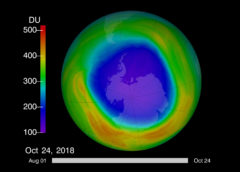Scientists from NASA and NOAA reported that in 2018, the hole in the ozone layer that forms over Antarctica was a little bit above average.
According to NASA, the annual ozone hole reached an average area coverage of 8.83 million square miles (22.9 square kilometers) in 2018, almost three times the size of the contiguous United States.
It ranks 13th largest out of 40 years of NASA satellite observations.
Colder-than-average temperatures in the Antarctic stratosphere created ideal conditions for destroying ozone this year, but declining levels of ozone-depleting chemicals prevented the hole from as being as large as it would have been 20 years ago.
Nations of the world began phasing out the use of ozone-depleting substances in 1987 under an international treaty known as the Montreal Protocol.
NOAA scientists monitor the thickness of the ozone layer and its vertical distribution above the South Pole by regularly releasing weather balloons carrying ozone-measuring “sondes” up to 21 miles (~34 kilometers) in altitude, and with a ground-based instrument called a Dobson spectrophotometer.
To learn more about NOAA and NASA efforts to monitor ozone and ozone-depleting gases, check out the links below.
ozone-hole-modest-despite-optimum-conditions-for-ozone-depletion
https://www.esrl.noaa.gov/csd/assessments/ozone/2014/twentyquestions/
Source: NASA
https://tnc.network/news/

Rod is a blogger, writer, filmmaker, photographer, daydreamer who likes to cook. Rod produces and directs the web series, CUPIC: Diary of an Investigator. He is also the editor, producer and administrator of STM Daily News, a part of the TNC Network.

